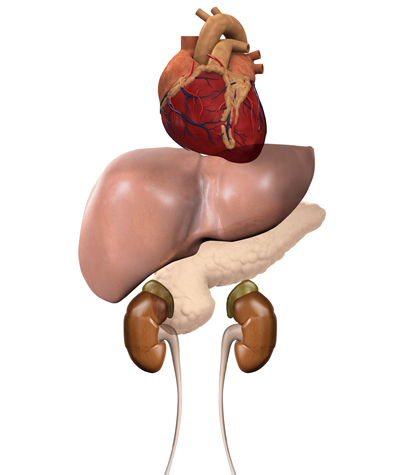Custodiol® HTK Solution is indicated for perfusion and flushing of donor kidneys, liver, pancreas and heart prior to removal from the donor or immediately after removal from the donor. The solution is left in the organ vasculature during hypothermic storage and transportation (not for continuous perfusion) to the recipient.
 Important Clinical Advantages
Important Clinical Advantages
- Only solution approved for use in both abdominal and thoracic cavities
- No unexpected adverse events in clinical studies7 (eg, arrhythmia, cardiac arrest)
- Low viscosity important in low-flow organs like the pancreas
- Low potassium content allows direct release into recipient’s circulatory system
- Buffered with histidine and histidine HCl. Doubles buffering capacity in transplanted organs, which moderates drop of pH Protects against edema – greater convenience
- Water-like viscosity for easier diffusion and faster cooling time
- No flushing required
- Convenient storage and package sizes
- 1-year shelf life
- 1/2-liter bottle
- 1-liter, 2-liter, and 5-liter bags
- Ready-to-use–no need for additives or filters
- Less expensive than UW and Celsior solutions CONFIDENCE
- Developed originally as a cardioplegic
* CUSTODIOL® has been used in almost 2 million cardiac procedures in Europe.2
Custodiol® HTK Solution is intended for perfusion and flushing donor kidney, liver, heart, and pancreas prior to removal from the donor and for preserving these organs during hypothermic storage and transport to the recipient. It is based on the principle of inactivating organ function by withdrawal of extracellular sodium and calcium, together with intense buffering of the extracellular space by means of histidine/histidine HCI, so as to prolong the period for which the organs will tolerate interruption of blood and oxygen. Only a small portion of the osmolality of Custodiol® HTK Solution is due to sodium and potassium. Its composition is similar to that of extracellular fluid.
Custodiol® HTK Solution is low in potassium concentration so that residual solution in the transplanted organ poses no danger to the recipient. This is particularly important in organs that take up relatively large amounts of the perfusate, which may appear in the recipient’s circulation.
Chemistry and Pharmacology
As a crystalloid solution, Custodiol® HTK Solution is considered an intracellular solution, i.e., electrolyte concentrations similar to an intracellular concentration, containing low concentrations of the electrolytes sodium, calcium, potassium and magnesium. Custodiol® HTK Solution also contains a high concentration of an amino acid buffering agent, histidine/histidine hydrochloride, the amino acid tryptophan a-ketoglutarate, and the osmotic agent mannitol. The histindine/histidine hydrochloride buffering system provides normal osmolarity and enhances the solution’s buffering capacity during the ischemic-induced acididosis.1,2 With the exception of mannitol, all constituents are normally found in the body.
Custodiol® HTK Solution is devoid of colloid and has a viscosity of 1.8 cP, which is similar to the viscosity of water (1.0020 cP). The osmolality of Custodiol® HTK Solution is 310 mosmol/kg. The pH of Custodiol® HTK Solution is 7.02 – 7.2 at 25°C.
The low sodium content makes it possible to use a high concentration of biological buffer systems, namely histidine and histidine HCL which confer a buffering capacity superior to that of blood. The histidine/histidine hydrochloride buffering system provides osmolarity and enhances the solution’s buffering capacity during ischemia-induced acidosis.1 Histidine is also an effective membrane protectant,2,3 and improves the provision of ATP.
Custodiol® HTK Solution contains amino acid tryptophan to protect cell membranes. a-ketoglutarate helps to stabilize cell membranes and is a substrate for anaerobic metabolism; it is an intermediary in the Krebs cycle and a precursor of nicotinamide adenine dinucleotide offering improved production of ATP during reperfusion and inhibiting the production of lactate through glycolysis.3,4,5
Mannitol maintains physiological or slightly increased osmolality and thereby counteracts the colloidal osmotic pressure of intracellular protein to reduce cellular edema. Mannitol may also act as a free-radical scavenger.4,5
The efficacy of the low sodium and low calcium concept of Custodiol® HTK Solution, buffered with Histidine, has been demonstrated in a number of studies. The advantages of Custodiol® HTK Solution to improve clinical outcomes are, in part, based on the buffer effect of histidine/histidine hydrochloride which may enhance the efficiency of anaerobic glycolysis. Also, the addition of mannitol has been shown to decrease cellular edema.3,6
Custodiol® Applications
- Custodiol® was originally designed as a cardoplegia solution and it effectively arrests the recovered heart. This level of arrest is not only electrical but also mechanical leading to reduced energy consumption.
- During reperfusion Custodiol® minimizes the ion gradient shift providing a safety margin.
- The high buffering capacity of Histidine is combined with the trytophan and alpha-ketoglutarate offering membrane protection and suppressing tissue acidosis.
- Low viscosity allows for quicker and more effective flushing with rapid cooling.
- The biochemical makeup of HTK makes it practical and easy to use.
- Custodiol® can be considered for the heart and abdominal organs as a “universal” preservation solution.
- Safety advantages includes the use of organic buffers, no mixing or two solution confusion, and the low K+ concentration eliminates the need for flushing and eliminates the risk of hyperkalemia while reducing the risk of post transplant arrhythmias.
- Custodiol® is also a cost effective replacement for Celsior and UW solution.
Because of its low-K+ content, the toxic effects of a high K+ concentration are avoided with HTK solution and there are fewer concerns about trace (K+) solution in the transplanted organ. Therefore, there is no need to flush the solution out of the organ before transplantation. When compared to other solutions this advantage reduces the risk of an incomplete flush.
The biochemical makeup of Custodiol® HTK solution is also practical and easier to use (with more complete penetration of organ vessels and structures), and its low viscosity (nearly identical to water) simplifies handling. Because of the complete cooling of the entire organ, no surface cooling is required after using Custodiol® HTK during the cardiac arrest phase, and cooling cuffs or similar devices placed behind the heart are not needed.



